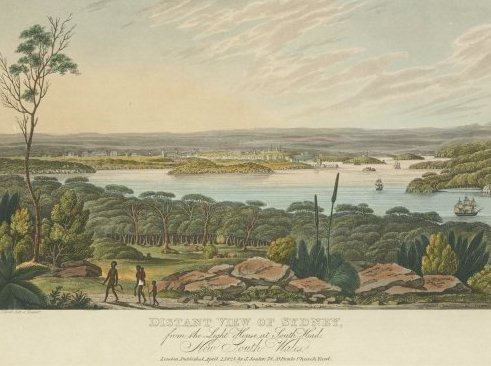When Captain Arthur Phillip and the First Fleet landed, first in Botany Bay and then in Port Jackson (Sydney Harbour), in January 1788, he was met by people who had lived on this land for many thousands of years. At least 1,500 people lived in the area between Botany Bay and Broken Bay and the intermediate coast.
There were two main languages spoken in the Sydney region - Darug and Tharawal. The Darug language had two main dialects - one spoken along the coast and the other in the hinterland (west of present-day Parramatta). Tharawal was spoken to the south of Botany Bay and as far west as the Georges River and possibly Camden.
People belonged to small groups (territorial clans) through which they were spiritually related to specific tracts of land - these clans included the Gadigal, Wanngal, Gamaragal, Wallumedegal and Boromedegal. The suffix 'gal' denotes 'people of', thus, for example, the Gadigal were the people of Gadi (also spelled Cadigal and Cadi respectively).
The 'district of Gadi' was reported to have stretched from South Head west to 'the cove adjoining this settlement' (Darling Harbour) - an area that would have included Centennial, Moore and Queens Parks. Watkin Tench referred to the Gadigal as 'those who reside in the bay of Cadi'. The 'bay of Cadi' is probably Kutti, the Aboriginal place name recorded for present-day Watsons Bay, and the present name of a small beach in the bay.
The Centennial Parklands Conservation Management Plan contains the following report that provides in depth detail of the pre-colonial history of the lands that are present day Centennial Parklands, which is where the text on this page comes from: Pre-colonial Aboriginal land and resource use in Centennial, Moore and Queens Parks - assessment of historical and archaeological evidence for Centennial Parklands Conservation Management Plan.
The land on which Waverley Cemetery is located is traditionally the land of the Cadigal clan of the Eora nation. As with most Aboriginal groups in Australia prior to European colonisation, the Cadigal lived a traditional hunter-gatherer lifestyle that used natural resources available in their environment to achieve physical and spiritual nourishment to sustain their way of life.
Evidence of the area’s occupation by the Cadigal is demonstrated in both archaeological (rock shelters, art sites, middens) and non-archaeological forms (creation sites, ceremonial places).

